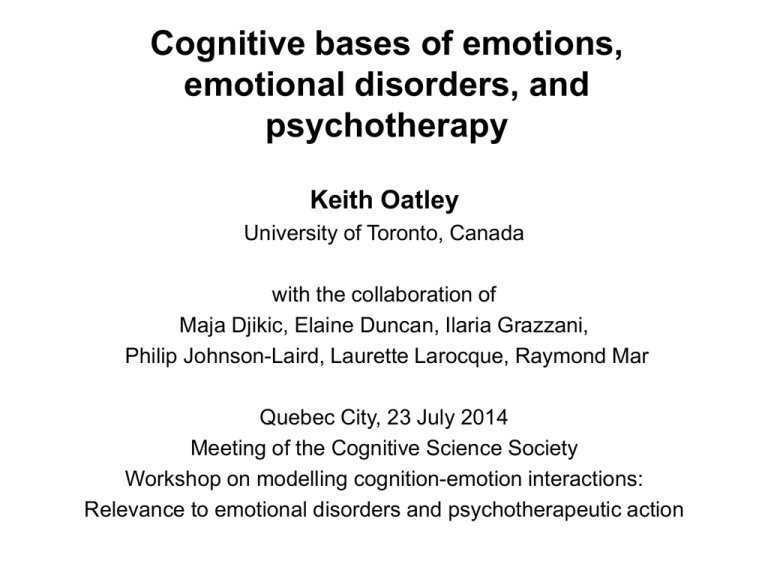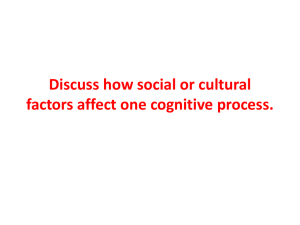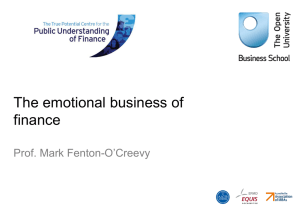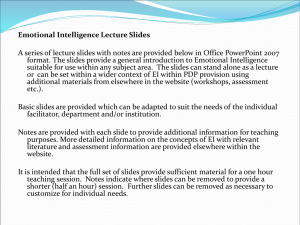Invited talk - School of Computer Science
advertisement

Cognitive bases of emotions, emotional disorders, and psychotherapy Keith Oatley University of Toronto, Canada with the collaboration of Maja Djikic, Elaine Duncan, Ilaria Grazzani, Philip Johnson-Laird, Laurette Larocque, Raymond Mar Quebec City, 23 July 2014 Meeting of the Cognitive Science Society Workshop on modelling cognition-emotion interactions: Relevance to emotional disorders and psychotherapeutic action Herbert Simon’s theory The most important proposal for the cognitive theory of emotions is that of Simon (1967). In intelligent beings that make plans, mental models of the world are never perfect and action is always limited. When such beings interact with other agents, the intentions of these other agents, too, are imperfectly known. Therefore events happen that are unexpected. Emotions are necessary to manage action at these junctures. Though cognitive science at first tended to neglect emotions, all the main theories of emotions are cognitive. Simon, H. A. (1967). Motivational and emotional controls of cognition. Psychological Review, 74, 29-39. Theories of emotion Among fruitful theories of emotion for thinking about emotional disorders and therapy are: Lazarus’s theory of stress and coping Frijda’s theory of action readiness Oatley & Johnson-Laird’s communicative theory Reisenzein’s belief-desire theory Lazarus, R. S. (1991). Emotion and adaptation. New York: Oxford University Press. Frijda, N. H. (2007). The laws of emotion. Mahwah, NJ: Erlbaum. Oatley, K., & Johnson-Laird, P. N. (2014). Cognitive approaches to emotions. Trends in Cognitive Sciences, 18, 134-140. Reisenzein, R. (2009). Emotional experience in the computational belief-desire theory of emotion. Emotion Review, 1, 206-213. Emotions Frijda proposes that: Emotions are based on appraisals of events in relation to concerns Appraisals are evaluations of events Each appraisal sets up a mode of action readiness The function of emotions is to give priority to particular concerns, and particular kinds of action readiness Nico Frijda’s types of action readiness • • • • • • • • • • • • • • • • • • 1. Acceptance 2. Nonacceptance 3. Attending 4. Disinterest 5. Affiliate 6. Avoid 7. Reject 8. Antagonism 9. Desire 10. Caring for 11. Exuberance 12. Domination 13. Submission 14. Helplessness 15. Hyperactivation 16. Hypoactivation 17. Tenseness 18. Inhibition Accepting presence or interaction Not accepting presence or interaction Acquiring information Not acquiring information Achieving or accepting close interpersonal interaction Decreasing interaction Refusing interaction Modifying unwanted target action Achieving positive hedonic outcome Improving target’s well-being Promoting gratuitous interactions Controlling others’ actions Following someone else’s wishes Desiring to act but not knowing how Increase of relational activity Decrease of relational activity Simultaneous opposing action tendencies Inhibition of activated action readiness The Communicative Theory of Emotions Emotions monitor events in relation to goals and action. Recurring kinds of events: successes, losses, dangers, impediments. Two kinds of signal: A. Configurational, of cognitive system and of relationship B. Propositional, about cause and object of the emotion The Communicative Theory of Emotions Basic emotions (heuristic modes): Some basic emotions can be either object-directed or objectindependent: happiness, sadness, fear, anger Some basic emotions are always object-directed: three kinds of love, plus disgust & contempt Theory explains: evolutionary heuristics in relation to the management of action, for instance when the unexpected happens Oatley, K., & Johnson-Laird, P. N. (2014). Cognitive approaches to emotions. Trends in Cognitive Sciences, 18, 134-140. Fundamental method of studying emotions: Emotion diaries Emotion diary records of 47 employed men and women, classified into five kinds of emotions Keith Oatley & Elaine Duncan (1994). The experience of emotions in everyday life. Cognition and Emotion, 8, 369-381. Emotions are communications to the self, but not always understandable In a proportion of emotional episodes and moods in diary studies (6%) the experiencer did not know what caused them. In emotional disorders, this proportion increases (Oatley & Duncan, 1992). In such diary studies 31% of the recorded episodes involved mixed emotions, with sadness plus anger, anger plus fear, and happiness plus fear being common mixtures. Oatley, K., & Duncan, E. (1992). Incidents of emotion in daily life. In K. T. Strongman (Ed.), International Review of Studies on Emotion (Vol. 2, pp. 250293). Chichester: Wiley. Interpersonal emotions configure relationships into distinctive modes Happiness — cooperation Sadness — disengagement & helping Anger — conflict Fear — collective avoidance of danger Think of these as scripts (Oatley, 2004). Aubé (e.g. 2009)writes of the relational mode of an emotion as based on a commitment operator. Michel Aubé, M. (2009). Unfolding commitments management: A systemic view of emotions. In J. Valverdu & D. Casacuberta (Eds.), Handbook of research on synthetic emotions and sociable robotics: New applications in affective computing and artificial intelligence (pp. 198-227). Hershey, PA: IGI Global. Keith Oatley (2004). Emotions: A brief history. Oxford: Blackwell. Emotions configure relationships In William Shakespeare’s (1595) A Midsummer Night’s Dream members of the audience witness the effects of having the juice of “a little western flower ” (as we might now say a peptide) dripped into a sleeper’s eyes. It causes the sleeper to fall in love with the first person he or she sees on waking. So when, on waking after receiving such an administration, Titania sees Bottom (transformed into a donkey), she falls in love with him. She says: I pray thee gentle mortal, sing again. Mine ear is much enamoured of thy note; And thy fair virtue’s force perforce doth move me On the first view to say, to swear, I love thee (3, 1, 130-133). A joint error … cartoon by Peg Parsons Event-prompted diaries: Mean ratings, on 0-10 scales, given by participants for the importance to them of the joint plan in which an error occurred and of the relationship with the other person involved in the plan, in Italy and in Canada. Ilaria Grazzani-Gavazzi & Keith Oatley (1999). The experience of emotions of interdependence and independence following interpersonal errors in Italy and Anglophone Canada. Cognition and Emotion, 13, 49-63. A conception of empathy Empathy has been described by de Vignemont & Singer as based on mirror-neurons, and involving: (i) having an emotion, which (ii) is in some way similar to that of another person, which (iii) is elicited by observation or imagination of the other’s emotion, and which involves knowing that (iv) the other is the source of one’s own emotion. Frederique de Vignemont & Tania Singer (2006). The empathetic brain: How, when, and why. Trends in Cognitive Sciences, 10, 435-441. Four empathetic modes of emotion Imagine two people, Anna and Beatrice Beatrice smiles at Anna; Anna feels happy and smiles back Beatrice is in tears; Anna is sad and tries sympathetically to help Beatrice frowns; Anna senses opposition and feels slightly angry Beatrice cries out in alarm; Anna becomes frightened Mental disorders Among cognitive theories of emotion, ours (see e.g. Oatley & Johnson-Laird, 2014) is the only one that has explicitly served as a basis for understanding emotional disorders (see, Oatley & Jenkins, 1992; Power & Dalgleish, 2008; Johnson-Laird, Mancini, & Gangemi, 2006.) According to Johnson-Laird et al. emotional disorders are hyperemotions. Johnson-Laird, P. N., Mancini, F., & Gangemi, A. (2006). A hyper-emotion theory of psychological illnesses. Psychological Review, 113, 822-841. Oatley, K., & Johnson-Laird, P. N. (1987). Towards a cognitive theory of emotions. Cognition and Emotion, 1, 29-50. Keltner, D., Oatley, K., & Jenkins, J. M. (2013). Understanding emotions, third edition. Hoboken, NJ: Wiley. Oatley, K., & Johnson-Laird, P. N. (2014). Cognitive approaches to emotions. Trends in Cognitive Sciences, 18, 134-140. Power, M., & Dalgleish, T. (2008). Cognition and emotion: From order to disorder, 2nd edition. Hove: Psychology Press. Life events (life stress) In medical-related conditions the important starting point is epidemiology. This is true for emotional disorders, where the important study is that of Brown and Harris (1978). They found that first episodes of depression were caused not primarily by something going wrong in people’s mindsbut something going wrong in their lives—a severe life event—most typically a loss, in conjunction with a vulnerability factor such as lack of social support. Subsequently, genetics have been found to be critical, too (e.g. Caspi et al., 2003) but the importance of life events must not be minimized. Brown, G. W., & Harris, T. O. (1978). Social origins of depression: A study of psychiatric disorder in women. London: Tavistock. Caspi, A., Sugden, K., Moffitt, T., E., Taylor, A., Craig, I. W., Taylor, A., et al. (2003). Influence on life stress on depression: moderation by a polymorphism in the 5-HTT gene. Science, 301, 386-389. Oatley, K., & Bolton, W. (1985). A social-cognitive theory of depression in reaction to life events. Psychological Review, 92, 372-388. Oatley, K. (2007). Slings and arrows: Depression and life events. The Psychologist, 20, 228-230. Sadness and depression . Depression and some anxiety states have the same structure of causation, and are based on the same underlying processes as ordinary emotions of sadness and fear, in relation to losses and dangers. Mayberg, H. S., Liotti, M., Brannan, S. K., McGinnis, S., Maharin, R., K., Jerabek, P. A., et al. (1999). Reciprocal limbic cortical function and negative mood: Converging PET findings in depression and normal sadness. American Journal of Psychiatry, 156, 675-682. Some current approaches to therapy Emotion focused therapy, understanding one’s emotions (e.g. Greenberg, 2008) Cognitive-behavioural therapy, keeping diaries, understanding what gives rise to emotions (see outcome studies) Psychoanalytic therapy as developing a story in which intentions have gone missing (Freud’s case of “Dora”) more recently Fonagy & Leyten’s (2009) mentalization therapy, based on attachment and theory-of-mind Cuijpers, P., van Stratton, A., Andersson, G., & van Oppen, P. (2008). Psychotherapy for depression in adults: A meta-analytic review of comparative outcome studies. Journal of Consulting and Clinical Psychology, 76, 909-922. Greenberg, L. S. (2008). The clinical application of emotion in psychotherapy. In M. Lewis, J. Haviland-Jones & L. Feldman-Barratt (Eds.), Handbook of emotions, third edition (pp. 88-101). New York: Guilford. Fonagy, P., & Luyten, P. (2009). A developmental, mentalization-based approach to the understanding and treatment of borderline personality disorder. Development and Psychopathology, 21, 1355-1381. The importance of narrative Bruner (1986) has explained that narrative is an account of human intentions and their vicissitudes. It therefore has the same basis as that of the causation of emotions in relation to goals and events that affect them. When one sees a patient, or client, the person gives a narrative of his or her life and troubles, typically of emotional states (e.g. depression, anxiety, anger) that are not willed and cannot be controlled. Freud’s take on this (see Oatley, 1990) was that the narrative lacked an essential ingredient: the intentions (goals) of the person telling the narrative had gone missing from the story. Bruner, J. (1986). Actual minds, possible worlds. Cambridge, MA: Harvard University Press. Oatley, K. (1990). Freud's psychology of intention: The case of Dora. Mind and Language, 5, 69-86. Cognitive analytic therapy A time-limited therapy developed by Tony Ryle in the early nineties, is based on the idea of enabling the patient (client), to understand how a particular emotional problem is set up and then maintained, and on how each problem of this kind plays out in relationships. An early part of the therapy involves diaries, and at the end of the first phase the therapist writes the patient (client) a narrative-based letter to reformulate the patient’s (client’s) life story, with the aim that the letter will be mutually agreed, and serve as the basis for therapeutic change. We might now see the setting up of an emotional problem, and its reformulation, as based on appraisal. Ryle, A & Kerr, I (2002). Introducing Cognitive Analytic Therapy: Principles and Practice. Chichester: Wiley. Approaches to therapy Most therapy, then, has a basis in narrative, and most involves clients coming better to be in charge of their own intentions (goals). Therapy is therefore related to reading narrative fiction. The Communicative Theory of Emotions has therapeutic implications: people can come better to understand transitions to intense emotional states, and to reflect on emotions as communications to themselves of important goals (related to ancient Stoic analyses, e.g. Epictetus.) Two therapeutic effects of reading fiction, both based in emotion One kind of effect (found by Raymond Mar and me with other colleagues) is that reading fiction gives rise to improved empathy and theory-of-mind. By means of it, we can come to understand others, via empathetic emotions, from the inside (cf. Fonagy’s mentalization therapy). The second kind of effect (found by Maja Djikic and me with other colleagues) is that through fiction that is artistic we can change our personalities by small amounts, not by means of persuasion, but in our own way. This effect is mediated by readers’ emotions. It’s dependent on the literary works being art rather than being designed to produce some particular emotional effect, as occurs, for instance, with thrillers, or being designed to persuade. Oatley, K. (2011). In the minds of others. Scientific American Mind, 22(6), 62-67. Art as enabling emotion-based change of personality First: Fiction. Maja Djikic and I (with other colleagues) assigned people to read either Anton Chekhov’s short story “The lady with the little dog” or a control text. Before and after this, we measured Big Five personality traits and intensity of ten emotions. The story is about a man who, while staying at a seaside resort, meets a woman whom he has seen walking with her dog. They begin an affair and at the end of their holiday they part. But their feelings for each other become stronger, and more important than anything else in their lives. The control text in non-fictional format was written by Maja Djikic as a report from a divorce court, with the same characters, events and information as Chekhov’s story. It was the same length and level of reading difficulty. Readers found it just as interesting, but not as artistic, as Chekhov’s story. Djikic, M., Oatley, K., Zoeterman, S., & Peterson, J. (2009). On being moved by art: How reading fiction transforms the self. Creativity Research Journal, 21, 24-29. Effects of reading Chekhov’s “The lady with the little dog” (art) compared with a courtroom account of the same events (control): Means of composite traits and emotions after reading, controlled for composite traits and emotions before reading. Maja Djikic, Keith Oatley, Sara Zoeterman, & Jordan Peterson (2008). On being moved by art: How reading fiction transforms the self. Creativity Research Journal, 20. 1 Indices of Change Traits Em otions 0.9 0.8 0.7 0.6 0.5 0.4 Control Condition Note. N = 166. Art Transformation of the self We found that reading Chekhov’s story, as compared with the control text, enabled people to change themselves (their personality). Each person changed in his or her own way. The changes were mediated by the amount of emotion readers experienced while reading. So far we have only found short-term effects, but we think that over time, such effects might cumulate. Indirect communication Søren Kierkegaard called this indirect communication: The indirect mode of communication makes communication an art in quite a different sense than when it is conceived in the usual manner ... To stop a man on the street and stand still while talking to him, is not so difficult as to say something to a passer-by in passing, without standing still and without delaying the other, without attempting to persuade him to go the same way, but giving him instead an impulse to go precisely his own way (pp. 246-247). Søren Kierkegaard, S. (1846). Concluding unscientific postscript (D. F. Swenson & W. Lowrie, Trans.). Princeton, NJ: Princeton University Press (This publication 1968). Art and the projection of our own meanings Art enables us to change, not in a way desired by an author but in our own way. By contrast, persuasion results in feeling, thinking, or acquiring dispositions, according to the goals of the writer. So artistic fiction is comparable to two kinds of relationship that enable change in an indirect way: a love relationship and the relationship of a certain kind of psychotherapy. In reading artistic fiction one is both oneself and a literary character, and this can prompt a perturbation in the autonomous system of personality. In psychotherapy, one can be both one’s usual self and another person in the transference, and this can enable a comparable effect. Djikic, M., & Oatley, K. (under revision). The art in fiction: From indirect communication to self-development. Psychology of Aesthetics, Creativity and the Arts. Computational issues There have been several approaches to the computational modelling of emotions. Frijda, N. H., & Swagerman, J. (1987). Can computers feel? Theory and design of an emotional system. Cognition and Emotion, 1, 235-257. Wright, I. Beaudoin, L. Sloman, A. (1996). Towards a design-based analysis of emotional episodes. Philosophy, Psychiatry, and Psychology, 3, 101-126. Mateas, M., & Stern, A. (2007). Writing Facade: A case study in procedural authorship. In P. Harrigan & N. Wardrip-Fruin (Eds.), Second person: Roleplaying and story in games and playable media (pp. 183-208). Cambridge, MA: MIT Press. Aubé, M. (2009). Unfolding commitments management: A systemic view of emotions. In J. Valverdu & D. Casacuberta (Eds.), Handbook of research on synthetic emotions and sociable robotics: New applications in affective computing and artificial intelligence (pp. 198-227). Hershey, PA: IGI Global. Nico Frijda’s types of action readiness • • • • • • • • • • • • • • • • • • 1. Acceptance 2. Nonacceptance 3. Attending 4. Disinterest 5. Affiliate 6. Avoid 7. Reject 8. Antagonism 9. Desire 10. Caring for 11. Exuberance 12. Domination 13. Submission 14. Helplessness 15. Hyperactivation 16. Hypoactivation 17. Tenseness 18. Inhibition Accepting presence or interaction Not accepting presence or interaction Acquiring information Not acquiring information Achieving or accepting close interpersonal interaction Decreasing interaction Refusing interaction Modifying unwanted target action Achieving positive hedonic outcome Improving target’s well-being Promoting gratuitous interactions Controlling others’ actions Following someone else’s wishes Desiring to act but not knowing how Increase of relational activity Decrease of relational activity Simultaneous opposing action tendencies Inhibition of activated action readiness Types of action readiness for sadness (in blue) • • • • • • • • • • • • • • • • • • 1. Acceptance 2. Nonacceptance 3. Attending 4. Disinterest 5. Affiliate 6. Avoid 7. Reject 8. Antagonism 9. Desire 10. Caring for 11. Exuberance 12. Domination 13. Submission 14. Helplessness 15. Hyperactivation 16. Hypoactivation 17. Tenseness 18. Inhibition Accepting presence or interaction Not accepting presence or interaction Acquiring information Not acquiring information Achieving or accepting close interpersonal interaction Decreasing interaction Refusing interaction Modifying unwanted target action Achieving positive hedonic outcome Improving target’s well-being Promoting gratuitous interactions Controlling others’ actions Following someone else’s wishes Desiring to act but not knowing how Increase of relational activity Decrease of relational activity Simultaneous opposing action tendencies Inhibition of activated action readiness Computational issues The approach that Phil Johnson-Laird and I are taking to model our theory is to use our 1989 semantic analysis of emotion terms, and to input episodes of emotion. These will be in narrative form collected from people, including people with current disorders. These episodes will be analyzed for events, goals and emotion terms, and also for emotional mood using Pennebaker et al’s (2001) Linguistic Inquiry and Word Count. We will then infer what emotion is being experienced. The output of the program will be predictions of kinds of action that are likely, and of changes could take place in the formulation. The program will be designed have a conversational interface, in which the emotional episodes can be discussed. Johnson-Laird, P. N., & Oatley, K. (1989). The language of emotions: An analysis of a semantic field. Cognition and Emotion, 3, 81-123. Pennebaker, J. W., Francis, M. E., & Booth, R. J. (2001). Linguistic Inquiry and Word Count (LIWC). LIWC 2001. Mahwah, NJ: Erlbaum. Fin Thank you From Indian poetics: everyday and literary emotions Bhava Rasa sexual delight the amorous or erotic laughter the comic sorrow the pitiable or tragic anger the furious perseverence the heroic fear the terrible disgust or disillusion the odious or loathsome wonder the marvelous serenity the peaceful Effects of reading fiction and non-fiction on social abilities If fiction is a simulation of the social world, a prediction follows. People who read a lot of fiction may possess enhanced theory-of-mind (empathetic) abilities, and social skills. This prediction was tested by examining lifetime exposure to fiction and nonfictional texts as measured by Keith Stanovich & Richard West’s Author Recognition Checklist, and investigating whether such exposure could predict performance on: • A test of empathetic theory of mind: The Mind in the Eyes Test • A test of social perception: The Interpersonal Perception Test Raymond Mar, Keith Oatley, Jacob Hirsh, Jennifer dela Paz, & Jordan Peterson (2006). Bookworms versus nerds: The social abilities of fiction and non-fiction readers. Journal of Research in Personality, 40, 694-712. Simon Baron-Cohen et al. (2001). The “Reading the Mind in the Eyes” Test Revised version: A (Baron-Cohen et al.,Journal 2001) study with normal adults, and adults with Asperger's syndrome or high-functioning autism. of Child Psychology and Psychiatry, 42, 241-251. Partial correlations between exposure to fiction or non-fiction (ART) and two measures of social ability: Mind in the Eyes (MIE) and Interpersonal Perception Task (IPT-15). (Raymond Mar, Keith Oatley, Jacob Hirsh, Jennifer dela Paz, & Jordan Peterson (2006). Bookworms versus nerds: The social abilities of fiction and nonfiction readers. Journal of Research in Personality, 40, 694-712.) Results – Partial Correlations 0.4 * Partial Correlation 0.3 0.2 ^ 0.1 0 -0.1 Nonfiction MIE IPT-15 Fiction -0.2 -0.3 -0.4 * * ^ p = .08 * p < .01 (Mar, Oatley, Hirsh, dela Paz, & Peterson, 2006) Conclusions Emotions configure the individual cognitive system to deal with recurring kinds of events, especially events in the social world. Emotions configure relationships, and hence allow people to coordinate with each other. Coordination involves mindreading: being able to understand other people ’ s emotions. This typically involves a process based on empathetic simulation and projection. We are good at this, but not that good. Fiction is simulation of the social world. We can enter into this world, by taking on the goals and plans of characters. Although we know the characters’ emotions, the emotions we experience are our own. Practice in the simulated social worlds of fiction improves empathetic skills (emotional intelligence), and can change personality. Nico Frijda’s list of types of action readiness • • • • • • • • • • • • • • • • • • 1. Acceptance 2. Nonacceptance 3. Attending 4. Disinterest 5. Affiliate 6. Avoid 7. Reject 8. Antagonism 9. Desire 10. Caring for 11. Exuberance 12. Domination 13. Submission 14. Helplessness 15. Hyperactivation 16. Hypoactivation 17. Tenseness 18. Inhibition Accepting presence or interaction Not accepting presence or interaction Acquiring information Not acquiring information Achieving or accepting close interpersonal interaction Decreasing interaction Refusing interaction Modifying unwanted target action Achieving positive hedonic outcome Improving target’s well-being Promoting gratuitous interactions Controlling others’ actions Following someone else’s wishes Desiring to act but not knowing how Increase of relational activity Decrease of relational activity Simultaneous opposing action tendencies Inhibition of activated action readiness








